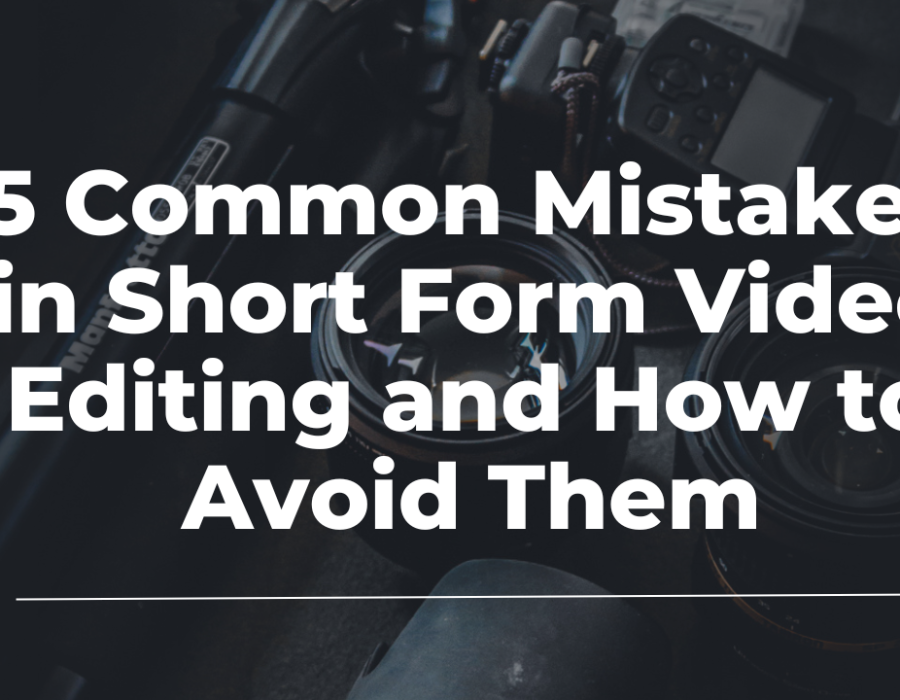Short-form videos have become a powerful tool for content creators and marketers alike, offering a quick and engaging way to connect with audiences. To make the most of this medium, many are turning to short-form video editing services to ensure their content stands out. However, creating a compelling short-form video is not as simple as it seems. There are common mistakes that can detract from the quality and impact of your content. To help you avoid these pitfalls, let's explore five common mistakes in short-form video editing and how you can steer clear of them.
Mistake 1: Overusing Transitions and Effects
Transitions and effects can add flair to your videos, but overusing them can quickly become distracting. Too many flashy transitions or excessive effects can overwhelm your audience, detracting from the message you’re trying to convey. The goal is to enhance your video, not overshadow it with unnecessary visual noise.
How to Avoid It:
Use transitions and effects sparingly. Stick to simple cuts and fades for most of your edits, and reserve more dramatic transitions for moments that truly need them. Focus on creating smooth, seamless edits that maintain the flow of your video without drawing attention away from the content itself.
Mistake 2: Ignoring Audio Quality
Audio is just as important as video in short-form content, yet it’s often overlooked. Poor audio quality, whether it’s background noise, inconsistent volume levels, or unclear dialogue, can ruin an otherwise well-produced video. Viewers are more likely to disengage if they struggle to hear or understand what’s being said.
How to Avoid It:
Invest in a good microphone or use a high-quality external mic if possible. Always check your audio levels during editing, ensuring that the sound is clear and balanced. If you’re recording in a noisy environment, consider using noise reduction tools available in many editing software programs. Additionally, adding background music can enhance your video, but make sure it doesn’t overpower the dialogue.
Mistake 3: Forgetting to Optimize for the Platform
Each social media platform has its own specifications and audience behaviors. Failing to optimize your videos for the platform you’re using can lead to poor performance, whether it’s from incorrect aspect ratios, inappropriate video lengths, or overlooked platform-specific features like hashtags or captions.
How to Avoid It:
Before you start editing, decide which platform your video will be published on and tailor your content accordingly. For instance, use a vertical 9:16 aspect ratio for TikTok and Instagram Reels, and a 1:1 or 16:9 ratio for Facebook and YouTube. Keep track of the ideal video length for each platform—shorter videos work best on TikTok, while Instagram Reels allows up to 90 seconds. Also, take advantage of platform-specific features like trending music, stickers, and hashtags to increase engagement.
Mistake 4: Neglecting the Storyline
Even in short-form videos, storytelling is crucial. Some creators focus too much on flashy visuals and neglect the storyline, resulting in videos that lack purpose or coherence. Without a clear narrative, your video can feel disjointed and leave viewers confused or uninterested.
How to Avoid It:
Before you start filming or editing, outline a clear storyline or script. Identify the main message you want to convey and structure your video around it. Even a 15-second video can have a beginning, middle, and end. Storyboarding can help you visualize the flow of your video and ensure that each shot contributes to the overall narrative. Keep your content focused and make sure every element serves the story you’re telling.
Mistake 5: Overcomplicating the Editing Process
When it comes to short-form videos, less is often more. Some creators fall into the trap of overcomplicating their edits by adding too many elements, such as multiple text overlays, graphics, or layered effects. This can lead to a cluttered and confusing video that loses its impact.
How to Avoid It:
Simplicity is key in short-form video editing. Focus on delivering your message clearly and concisely. Avoid the temptation to add unnecessary elements that don’t enhance the viewer’s experience. Use clean, minimalistic edits that keep the audience’s attention on the content rather than on the editing techniques.
Conclusion
Creating impactful short-form videos requires a balance of creativity and technical skill. By leveraging professional video editing services and avoiding common mistakes—overusing transitions, neglecting audio quality, failing to optimize for platforms, ignoring the storyline, and overcomplicating the editing process—you can produce videos that engage and resonate with your audience. Keep these tips in mind, and you’ll be well on your way to mastering short-form video editing.
FAQs
- Why should I avoid using too many transitions and effects in my videos?
- Overusing transitions and effects can distract from your video’s message and make it feel chaotic. It’s better to use them sparingly to maintain focus on the content.
- How can I improve the audio quality in my short-form videos?
- Use a good microphone, check your audio levels during editing, and reduce background noise. Make sure any background music complements rather than competes with your dialogue.
- What are the benefits of optimizing my videos for specific platforms?
- Optimizing your videos for the platform ensures they meet technical requirements and are more likely to engage the audience effectively, leading to better performance.
- Why is storytelling important in short-form videos?
- A clear storyline helps your video feel coherent and purposeful, making it more engaging and memorable for viewers.
- How can I avoid overcomplicating my video edits?
- Keep your editing simple and focused on delivering your message. Avoid adding unnecessary elements and ensure that every edit serves the story you’re telling.




.jpg)

Comments